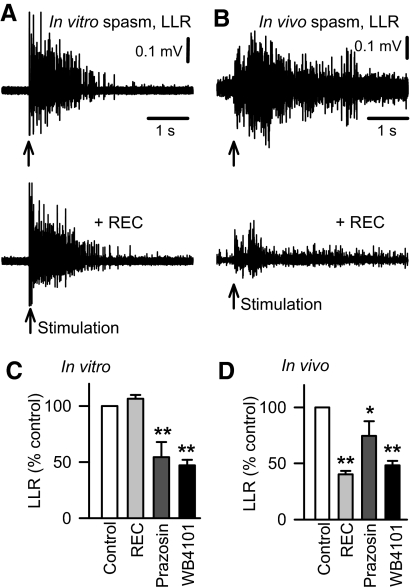Fig. 3.
Endogenous activation of the α1 adrenergic receptor is the result of constitutive activity in vitro, but a combination of constitutive and ligand activity in vivo. A: LLR in chronic spinal rat, evoked in the isolated in vitro spinal cord (as described in Fig. 1, top plot) and after blocking the action of endogenous NA (or similar ligand) with application of the α1A neutral antagonist REC15/2739 (abbreviated REC; 10 μM, bottom plot). B: long-lasting reflex spasm in awake chronic spinal rat evoked by electrical/cutaneous stimulation of the tail and recorded with tail muscle EMG (LLR computed 0.5–4 s post stimulus, as in Fig. 1) before (top plot) and after blocking endogenous action of NA at the α1A receptor with local intrathecal (IT) injection of REC15/2739 (5 mM in 30 μl). Normalized group mean of chronic spinal rat LLRs recorded in vitro (C) and in vivo (D) after application of the α1 receptor neutral antagonist REC15/2739 (gray bars, in vitro: 5–10 μM, n = 24; in vivo: IT injection of 3–10 mM in 30 μl; n = 5), and after application of inverse α1 receptor agonists prazosin (dark gray bars, in vitro: 1 μM, n = 24; in vivo: IT injection, 1 mM in 30 μl, n = 9) and WB4101 (black bars, in vitro: 3–5 μM, n = 16; in vivo: IT injection, 1–3 mM in 30 μl; n = 5). *, P < 0.05, **, P < 0.01. Error bars, SE. All recordings were made in the presence of RX821002 (in vitro: 0.5–1 μM; in vivo: intraperitoneal injection, 1 mg/kg).

